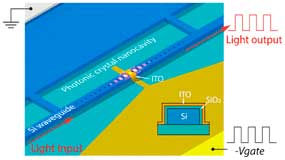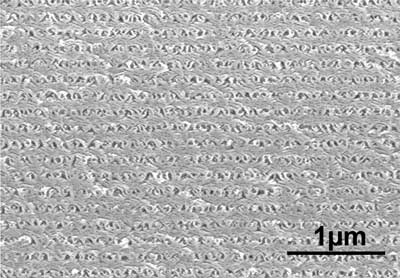
Monday, January 22, 2018
The world's smallest electro-optic modulator could lead to big energy savings
Researchers have designed and fabricated the world?s smallest electro-optic modulator, which could mean major reductions in energy used by data centers and supercomputers.
Proton transport in graphene shows promise for renewable energy
Researchers have discovered another new and unexpected physical effect in graphene - membranes that could be used in devices to artificially mimic photosynthesis.

A new approach to rechargeable batteries
New metal-mesh membrane could solve longstanding problems and lead to inexpensive power storage.

Engineers design artificial synapse for brain-on-a-chip hardware
Design is major stepping stone toward portable artificial-intelligence devices.

Researchers make thermochromic windows with perovskite solar cell
Researchers discovered that a form of perovskite works surprisingly well as a stable and photoactive semiconductor material that can be reversibly switched between a transparent state and a non-transparent state, without degrading its electronic properties.

Optical nanoscope allows imaging of quantum dots
Physicists have developed a technique based on optical microscopy that can be used to create images of atoms on the nanoscale. In particular, the new method allows the imaging of quantum dots in a semiconductor chip.

Magnetic semiconductor layers of a new type
A ferromagnetic semiconductor featuring room Curie temperature.

Multifunctional nanomedicine platform for the delivery of gene therapeutics
Thermo-triggered release of a genome-editing machinery by modified gold nanoparticles for tumor therapy.

Multifunctional nanomedicine platform for the delivery of gene therapeutics
Thermo-triggered release of a genome-editing machinery by modified gold nanoparticles for tumor therapy.

Making fuel cells for a fraction of the cost
Scientists report the development of an inexpensive, efficient catalyst material for a type of fuel cell called a polymer electrolyte membrane fuel cell (PEMFC), which turns the chemical energy of hydrogen into electricity and is among the most promising fuel cell types to power cars and electronics.

Charge order and electron localization in a molecule-based solid
In new work, researchers report a Verwey-type charge-ordering transition in a different class of mixed-valence compounds that is composed of negatively charged dioxygen molecules.

Charge order and electron localization in a molecule-based solid
In new work, researchers report a Verwey-type charge-ordering transition in a different class of mixed-valence compounds that is composed of negatively charged dioxygen molecules.

Charge order and electron localization in a molecule-based solid
In new work, researchers report a Verwey-type charge-ordering transition in a different class of mixed-valence compounds that is composed of negatively charged dioxygen molecules.

Charge order and electron localization in a molecule-based solid
In new work, researchers report a Verwey-type charge-ordering transition in a different class of mixed-valence compounds that is composed of negatively charged dioxygen molecules.

New metal-semiconductor interface for brain-inspired computing
Physicists have combined a niobium doped strontium titanate (SrTiO3) semiconductor with ferromagnetic cobalt. At the interface, this creates a spin-memristor with storage abilities, paving the way for neuromorphic computing architectures.

New semiconductor processing technology with nanosponges
Researchers have succeeded in developing a method for the controlled manufacture of porous silicon carbide.

New fuel cell technology runs on solid carbon
Advancements allow the fuel cell to utilize about three times as much carbon as earlier direct carbon fuel cell (DCFC) designs.

Taking control at the junction
Fine tuning the composition of nitride alloys can further the development of optical and electronic interface devices.

Two dimensional circuit with magnetic quasi-particles
Researchers have shown for the first time, in an initial model, that magnon current flow is possible in an integrated magnon circuit, in which case the components are only being connected two dimensionally.

Palladium nanoparticles can repair atomic dislocations in their crystal structure
A new study has shown that some nanoparticles can 'self-heal' after experiencing intense strain, once that strain is removed. This self-healing behavior could be worth exploring in other materials.

Subscribe to:
Posts (Atom)
